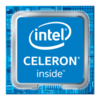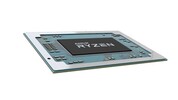Intel Celeron N5100 vs AMD 3015Ce vs AMD 3015e
Intel Celeron N5100
► remove from comparison
The Intel Celeron N5100 is a quad-core SoC of the Jasper Lake series that is primarily intended for inexpensive notebooks and was announced in early 2021. The four Tremont CPU cores clock between 1.1 and 2.8 GHz (single core Burst) and offer no HyperThreading (SMT). The N5100 uses 1.5 MB L2 and 4 MB L3 cache. The chip is manufactured in 10nm at Intel (most likely in the same process as Ice Lake).
Architecture
The processor architecture is called Tremont and a complete redesign compared to the old Golmont Plus cores in the predecessor. According to Intel, the single thread performance of a core could be improved by 30% on average (10 - 80% in all tests of SPECint and SPECfp).
Features
In addition to the quad-core CPU block, the SoC integrates a 24 EU Intel UHD Graphics GPU clocked from 350 - 800 MHz and a LPDDR4(x) dual channel memory controller (up to 16 GB and 2933 MHz). The chip now also partly integrates Wi-Fi 6 (Gig+), 8 PCIe 3.0 lanes, 14 USB 2.0/ 3.2 ports and two SATA 6.0 ports. The package got bigger and measures 35 x 24 mm (compared to 25 x 24 mm for the N5030 e.g.). The SoC is directly soldered to the mainboard (BGA) and can't be easily replaced.
Performance
While we have not tested a single system powered by the N5100 as of August 2023, it's safe to expect the chip to be 10% to 20% slower than the N6000, as far as multi-thread performance is concerned. In other words, this is a fairly slow processor that is unlikely to make anybody happy.
Power Consumption
Like most other N-class Intel processors, this Celeron has a 6 W default TDP (also known as the long-term power limit). This is rather low; a small metal plate is all it takes to dissipate heat generated by such a CPU.
The Celeron N5100 is manufactured on Intel's first-generation or second-generation [no exact data available] 10 nm process for average, as of early 2023, energy efficiency.
AMD 3015Ce
► remove from comparison
The AMD 3015Ce (Codename Dali) is a mobile APU that integrates two Zen cores (with SMT, therefore 4 threads) clocked at 1.2 to 2.3 GHz. It is the Chromebook version of the AMD 3015e with identical specifications. The integrated Radeon graphics card offers 3 CUs at up to 600 MHz (Radeon RX Vega 3). The single channel memory controller supports only DDR4-1600. The chip is manufactured in 14nm and officially counted to the 3000 series of mobile processors.
More information on Raven Ridge can be found in our launch article.
Performance
The average 3015Ce in our database is about as fast as Intel's older Y-class dual-core chips such as the m3-7Y30 are, as far as multi-thread benchmark scores are concerned. Which is not fast at all. In fact, the AMD chip is not much better than Intel Celeron N-series offerings such as the N4100.
Power consumption
This AMD APU has a 6 W default TDP (also known as the long-term power limit). TDP values that low are typical for affordable laptops as well as ultra-compact mini-PCs, mostly with no active cooling solution.
The 3015Ce is manufactured on a 14 nm process making for subpar, as of late 2022, energy efficiency.
AMD 3015e
► remove from comparison
The AMD 3015e is a dual-core, quad-thread processor (APU) of the Pollock product family. Its cores run at 1.2 GHz to 2.3 GHz and it has a low 6 W TDP, making it a good option for use in passively cooled laptops and ultra-small mini-PCs of the more affordable flavour. The processor first saw the light of day in 2020; it has a built-in Vega 3 graphics adapter running at up to 600 MHz.
Architecture & Features
This chip makes use of the rather dated Zen architecture for comparatively poor performance-per-MHz values. It has 4 MB of L3 cache and several PCI-Express 3.0 lanes for connecting NVMe SSDs, discrete graphics cards and other devices; its RAM controller functions in single-channel mode and supports DDR4-1600 memory or slower. AMD 3015e is compatible with Windows 10, Windows 11, and many Linux distros as well. Please note this is not a user-replaceable CPU. It gets soldered permanently to the motherboard (FT5 socket interface).
Performance
While we have not tested a single system built around the 3015e as of August 2023, we have some performance data for the 3050e, a chip that is just slightly superior. Based on that, the 3015e is a low-end option competing with the likes of the Intel N4500 and the Intel 4415U that is good for basic tasks and applications only.
Graphics
The Vega 3 runs at an unusually low clock rate of 600 MHz, or less. It will let you connect several monitors in resolutions as high as UHD 2160p, and it will happily decode AVC, HEVC and VP9-encoded videos, too. The latest AV1 video codec is not supported; such a video will have to be software-decoded, with the limited CPU horsepower putting a hard limit on video resolution that can be played back without stuttering. Expect to see a lot of dropped frames when watching a 1080p30 video.
Gaming is possible to a very limited extent with this iGPU. Even if it's CS:GO or a similarly old game that you want to play, be prepared to set the settings to Low.
Power consumption
This little AMD processor has a low default TDP (also known as the long-term power limit) of 6 W, making it one of the better options for use in a passively cooled laptop, tablet, mini-PC.
The AMD 3015e is manufactured on a 14 nm process leading to poor, as of mid 2023, energy efficiency.
| Model | Intel Celeron N5100 | AMD 3015Ce | AMD 3015e | ||||||||||||||||||||||||||||||||||||||||||||||||
| Codename | Jasper Lake | Pollock (Zen) | Pollock (Zen) | ||||||||||||||||||||||||||||||||||||||||||||||||
| Series | Intel Jasper Lake | AMD Raven Ridge (Ryzen 2000 APU) | AMD Raven Ridge (Ryzen 2000 APU) | ||||||||||||||||||||||||||||||||||||||||||||||||
| Series: Raven Ridge (Ryzen 2000 APU) Pollock (Zen) |
|
|
| ||||||||||||||||||||||||||||||||||||||||||||||||
| Clock | 1100 - 2800 MHz | 1200 - 2300 MHz | 1200 - 2300 MHz | ||||||||||||||||||||||||||||||||||||||||||||||||
| L2 Cache | 1.5 MB | 1 MB | 1 MB | ||||||||||||||||||||||||||||||||||||||||||||||||
| L3 Cache | 4 MB | 4 MB | 4 MB | ||||||||||||||||||||||||||||||||||||||||||||||||
| Cores / Threads | 4 / 4 | 2 / 4 | 2 / 4 | ||||||||||||||||||||||||||||||||||||||||||||||||
| TDP | 6 Watt | 6 Watt | 6 Watt | ||||||||||||||||||||||||||||||||||||||||||||||||
| Technology | 10 nm | 14 nm | 14 nm | ||||||||||||||||||||||||||||||||||||||||||||||||
| max. Temp. | 105 °C | 105 °C | 105 °C | ||||||||||||||||||||||||||||||||||||||||||||||||
| Socket | BGA1338 | FT5 | FT5 | ||||||||||||||||||||||||||||||||||||||||||||||||
| Features | DDR4-2933/LPDDR4x-2933 RAM, PCIe 3, GNA, MMX, SSE, SSE2, SSE3, SSSE3, SSE4.1, SSE4.2, VMX, SMEP, SMAP, EIST, TM1, TM2, Turbo, AES-NI, RDRAND, RDSEED, SHA | DDR4-1600 RAM (sin. chan.), PCIe 3, MMX, SSE, SSE2, SSE3, SSSE3, SSE4A, SSE4.1, SSE4.2, AVX, AVX2, BMI2, ABM, FMA, ADX, SMEP, SMAP, SMT, CPB, AES-NI, RDRAND, RDSEED, SHA, SME | DDR4-1600 RAM, PCIe 3, MMX, SSE, SSE2, SSE3, SSSE3, SSE4A, SSE4.1, SSE4.2, AVX, AVX2, BMI2, ABM, FMA, ADX, SMEP, SMAP, SMT, CPB, AES-NI, RDRAND, RDSEED, SHA, SME | ||||||||||||||||||||||||||||||||||||||||||||||||
| iGPU | Intel UHD Graphics (Jasper Lake 24 EU) (350 - 800 MHz) | AMD Radeon RX Vega 3 ( - 600 MHz) | AMD Radeon RX Vega 3 ( - 600 MHz) | ||||||||||||||||||||||||||||||||||||||||||||||||
| Architecture | x86 | x86 | x86 | ||||||||||||||||||||||||||||||||||||||||||||||||
| Announced | |||||||||||||||||||||||||||||||||||||||||||||||||||
| Manufacturer | ark.intel.com | www.amd.com | www.amd.com | ||||||||||||||||||||||||||||||||||||||||||||||||
| L1 Cache | 192 KB | 192 KB |
Benchmarks
Average Benchmarks Intel Celeron N5100 → 100% n=2
Average Benchmarks AMD 3015Ce → 76% n=2
Average Benchmarks AMD 3015e → 61% n=2
* Smaller numbers mean a higher performance
1 This benchmark is not used for the average calculation













